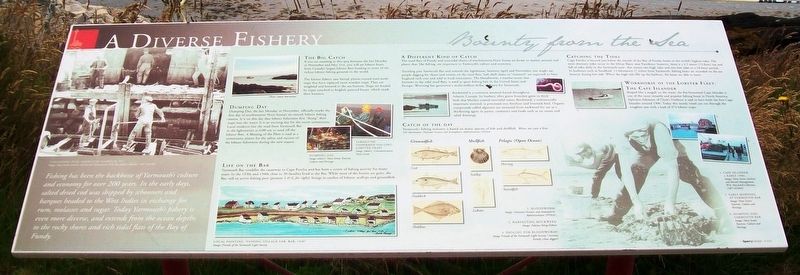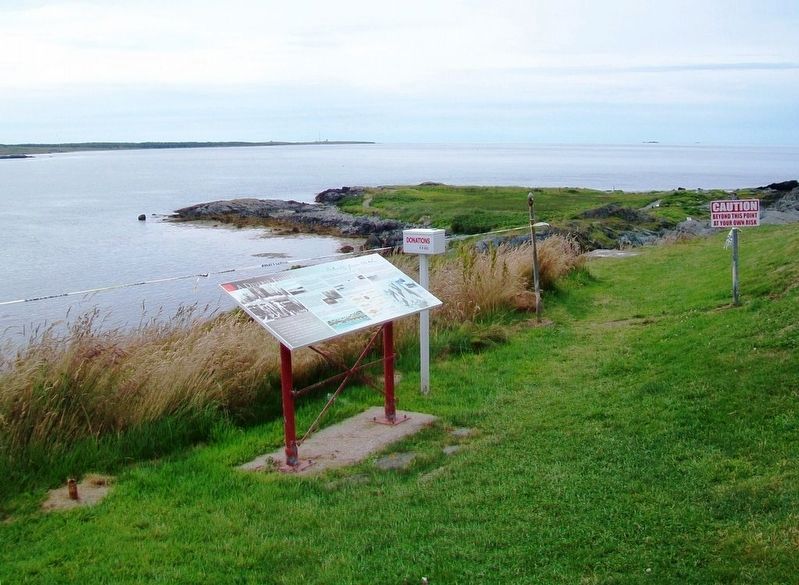A Diverse Fishery
Fishing has been the backbone of Yarmouth's culture and economy for over 200 years. In the early days, salted dried cod was shipped by schooners and barques headed to the West Indies in exchange for rum, molasses and sugar. Today Yarmouth's fishery is even more diverse, and extends from the ocean depth's to the rocky shores and rich tidal flats of the Bay of Fundy.
The Big Catch
If you are standing in this spot between the last Monday in November and May 31st, you will see lobster boats from Canada's largest lobster fleet heading to some of the richest lobster fishing grounds in the world.
The lobster fishery uses baited, plastic coated steel-mesh traps that have replaced most wooden traps. They are weighted and lowered to the sea bottom. Traps are hauled by ropes attached to brightly painted buoys, which mark their location.
Dumping Day
Dumping Day, the last Monday in November, officially marks the first day of southwestern Nova Scotia's six-month lobster fishing season. It is on this day that lobster fishermen first "dump" their traps into the water. It is an exciting day for the entire community. Local residents line the road from Yarmouth Bar to the lightstation at 6:00 am to send off the lobster fleet. A Blessing of the Fleet is read as a community prayer for the safety and success of
Life on the Bar
Yarmouth Bar straddles the causeway to Cape Forchu and has been a centre of fishing activity for many years. In the 1930s and 1940s close to 30 families lived at the Bar. While most of the homes are gone, the Bar, still an active fishing port (pictures 5 & 6, far right), brings in catches of lobster, scallops and groundfish.
A Different Kind of Catch
The mud flats of Fundy and intertidal shores of southwestern Nova Scotia are home to marine animals and plants that, like fishing, are important to Yarmouth's culture and economy.
Traveling past Yarmouth Bar and towards the lighthouse, between April and November, you might see people digging for clams and worms on the mud flats. Soft shell crabs or "steamers" are exported to New England each year and sold to local restaurants. The bloodworm, a marine worm that burrows in the tidal mud flats, is used as sport fishing bait in the United States and Europe. Worming has generated a multi-million dollar industry for Yarmouth.
Rockweed is a common seaweed found throughout Atlantic Canada. Its leathery olive green branches grow in thick beds that blanket coastal intertidal zones. Rockweed, a commercially important seaweed, is processed into fertilizer and livestock feed. Organic compounds called alginates are extracted from rockweed
Catch of the day
Yarmouth's fishing industry is based on many species of fish and shellfish. Here are just a few.
Cod Scallop Herring Haddock
Lobster Swordfish Halibut
Catching the Tides
Cape Forchu is located just below the mouth of the Bay of Fundy, home to the world's highest tides. The most dramatic tides occur in the Minas Basin near Parrsboro; however, there is a 4.5 metre (15-foot) rise and fall of tides daily in the Yarmouth area- that means two high tides and two low tides in a 24-hour period. In harbours such as Sandford, 12 kilometers (7 miles) from Yarmouth, fishing boats are stranded on the sea bottom during low tide. When the high tide fills up the harbour, the boats are able to leave.
Workhorse of the Lobster Fleet: The Cape Islander
Shaped like a seagull on the water, the flat-bottomed Cape Islander is one of the most versatile and popular fishing boats in North America. Ephraim Atkinson of Clark's Harbour is said to have built the first Cape Islander around 1906. Today this sturdy vessel can cut through the roughest seas with a load of 375 lobster traps.
[Photo captions, from left to right, read]
"Unloading Fish,
Dumping Day
Yarmouth Fishermen Hauling Lobster Traps
Local Painting "Fishing Village Yar. Bar, 1930"
1. Bloodworm
2. Harvesting Rockweed
3. Digging for Bloodworms
4. Cape Islander, c. Early 1900s.
5. Early Morning at Yarmouth Bar
6. Dumping Day, Yarmouth Bar
Erected 2008 by the Friends of the Yarmouth Light Society.
Topics. This historical marker is listed in these topic lists: Animals • Environment • Man-Made Features • Waterways & Vessels. A significant day of the year for for this entry is May 31.
Location. 43° 47.641′ N, 66° 9.311′ W. Marker is in Cape Forchu, Nova Scotia, in Yarmouth County. Marker is at the Cape Forchu Lightstation. Touch for map. Marker is at or near this postal address: 1856 Nova Scotia Route 304, Cape Forchu NS B5A 4A7, Canada. Touch for directions.
Other nearby markers. At least 8 other markers are within walking distance of this marker. Welcome to the Leif Ericson Trail (within shouting distance of this marker); Cape Forchu's Guiding Light (within shouting distance of this marker); In Dire Need of a Lighthouse (within shouting distance of this marker); The Power of the Sea (within shouting distance of this marker); Phare Cap-Forchu / Cape Forchu Lightstation (within shouting distance of this marker); Lost to the Sea / Perdus en Mer (within shouting distance of this marker); Pieces of the Past (about 120 meters away, measured in a direct line); Explosive Geology (about 120 meters away). Touch for a list and map of all markers in Cape Forchu.
Also see . . .
1. Southwest Nova Scotia: Lobster by Trap. This Fish entry (Submitted on August 22, 2017, by William Fischer, Jr. of Scranton, Pennsylvania.)
2. Lobster Fishery in Southwest Nova Scotia. YouTube video from This Fish (Submitted on August 22, 2017, by William Fischer, Jr. of Scranton, Pennsylvania.)
3. Welcome To W. Laurence Sweeney Fisheries Museum. Museum Website (Submitted on July 24, 2020, by Larry Gertner of New York, New York.)
4. Cape Forchu: A Light Like No Other. Cape Forchu Lighthouse Website (Submitted on August 22, 2017, by William Fischer, Jr. of Scranton, Pennsylvania.)
Credits. This page was last revised on March 12, 2021. It was originally submitted on August 22, 2017, by William Fischer, Jr. of Scranton, Pennsylvania. This page has been viewed 189 times since then and 16 times this year. Photos: 1, 2. submitted on August 22, 2017, by William Fischer, Jr. of Scranton, Pennsylvania.

